- Finance
-
Equipment
- Beverage
- Coffee
-
Cooking
- Shop all cooking
- Bratt pans
- Char grills
- Chicken rotisseries
- Combi ovens
- Contact grills
- Convection ovens
- Conveyor toasters
- Cooktops
- Cooktop oven combos
- Crepe and pancake makers
- Deck ovens
- Fryers and oil filters
- Griddles
- Kebab machines
- Microwaves
- Pasta cookers
- Pizza ovens
- Range ovens
- Rice cookers
- Salamander grills
- Sous vide
- Speed ovens
- Steamers
- Tandoor ovens
- Toaster grills
- Waffle makers
- Wok burners
- Other
- Dishwashers
- Food display
- Food preparation
- Stainless steel
- Laundry
- Point of sale
-
Refrigeration
- Shop all refrigeration
- Blast chillers
- Chest freezers
- Countertop fridges
- Display freezers
- Display fridges
- Gelato freezers
- Ice-cream machines
- Ice machines
- Pizza prep fridges
- Refrigerated drawers
- Sandwich prep fridges
- Slushie machines
- Under counter freezers
- Under counter fridges
- Upright freezers
- Upright fridges
- Other
- Restaurant furniture
- Shop all equipment
- Customers
- FAQs
- Resources
- About Us
Share
Best commercial food processors: Buyer's guide
article
What’s inside this buyer’s guide
- Introduction
- Types of food processors
- Food processors vs blenders
- Food processor motors
- Other features to consider
- Types of food processor discs and blades
- Best commercial food processors
- Used commercial food processors — worth considering?
- Frequently asked questions
- Food processors glossary
- Keep your cash, use ours!
Efficiency, versatility, and precision – these are a few words that encapsulate the essence of a commercial food processor.
As a powerhouse of food preparation in professional kitchens, a commercial food processor plays an integral role in streamlining operations, saving time, and enhancing culinary outcomes.
From chopping and grating to slicing and pureeing, these dynamic appliances automate a range of tasks that would otherwise consume substantial manual effort.
Our buyer's guide is designed to help you select the perfect food processor for your specific needs.
We'll dive into the different features and types of food processors available and recommend the finest makes and models.
Types of food processors
To choose the right industrial food processor for your needs, it's essential to understand the different types available and their features.
Let's dive in!
Batch bowl
- Designed to process food in a large, enclosed bowl, with capacities usually ranging from 2 to 5 litres.
- They provide a variety of cutting options including chopping, grating, slicing, and shredding thanks to multiple blade/disk attachments.
- Known for delivering uniform results, critical for upholding consistency in a commercial kitchen.
- Ideal for recipes requiring precise processing duration or blending of ingredients, making it highly suitable for soups, sauces, and marinades.
Continuous feed
- Enables food to be processed as it's fed through a chute, outputting directly into a separate container, improving workflow.
- Known for its quick processing speed, it ensures consistency in cuts while handling large volumes of food.
- Best suited for repetitive tasks such as shredding cheese or slicing vegetables for large batches, enhancing efficiency in a high-volume kitchen.
Combination (batch bowl & continuous feed head)
- Hybrid model that offers the versatility of both batch bowl and continuous feed processors, catering to diverse culinary needs.
- Flexibility in batch and continuous processing allows it to handle different volume needs efficiently.
- A boon for commercial kitchens with diverse menu items, requiring different types of food processing tasks.
Bowl choppers (Buffalo choppers)
- Equipped with a rotating bowl and horizontal blades, designed for fine chopping and blending tasks.
- Works at high speeds, offering superior control over the chopping coarseness or fineness.
- They have a large capacity, typically up to 14 litres, making them ideal for heavy-duty chopping tasks, particularly for meats, vegetables, and coarse spreads or pâtés.
Vertical cutter mixers (VCM)
- Characterised by a large vertical mixing bowl and high-speed rotating blades.
- They operate at very high speeds, allowing them to chop, puree, blend and mix large quantities of ingredients quickly.
- With capacities up to 30 litres, they're ideal for preparing large batches of foods, like salad dressings, or kneading dough in commercial bakeries and pizzerias.
- Many VCMs also offer variable speed options and have a "pulse" function for precise control over processing.
Food processors vs blenders
Choosing the right equipment for your commercial kitchen is important for efficiency and precision in food preparation.
While the line between blenders and food processors can be blurry, referring to the table below will provide a clear comparison of their features and capabilities.
This will enable you to make an informed decision and select the ideal equipment that aligns with your specific needs, ensuring optimal results in your culinary endeavours.
|
Features |
Food Processors |
Blenders |
|
Functionality |
Versatile with multiple functions including chopping, slicing, grating, pureeing, and kneading. |
Primarily used for blending, pureeing, and emulsifying ingredients. |
|
Blade types |
Interchangeable blades for various functions. Some models offer additional attachments for kneading dough or making pasta. |
Typically, one fixed blade at the bottom of the jar with a high-speed motor for blending. Some high-end models might offer interchangeable blades. |
|
Capacity |
Comes in a variety of sizes, often larger than blenders, ranging from 1.5 to 3.5 litres (standard) in most models. |
Usually smaller than food processors, ranging from 1 to 2 litres for most models. |
|
Consistency |
Can process a range of textures from roughly chopped to finely minced or pureed. |
Best for creating smooth and liquid textures, such as soups, smoothies, and sauces. |
|
Food type |
Works well with both soft and hard foods, including vegetables, nuts, and dough. |
Excels at processing liquid and softer items. Not suitable for hard items like coffee and nuts unless it's a high-power model. |
|
Design |
Typically wider and shorter, allowing for the addition of more and larger food items. |
Generally taller and narrower, designed to pull ingredients down towards the blades for a smooth blend. |
|
Cleaning |
Most parts are usually detachable and dishwasher-safe. |
Typically easier to clean due to simpler construction, but cleaning around the blades can be tricky. |
Food processor motors
The motor power of an industrial food processor is like the engine of a sports car. It directly influences the machine's ability to handle various tasks with efficiency and precision.
In commercial settings, food processors typically feature motor power ranging from 0.5 to 2 horsepower, which is equivalent to approximately 370 to 1500 watts.
The higher the wattage, the greater the motor power, enabling the food processor to tackle heavy-duty tasks and process a wide range of ingredients with ease.
Here's a table providing a summary of motor power ranges for commercial food processors:
|
Motor power range |
Horsepower range |
Wattage range |
|
Low |
0.5 - 0.75 horsepower |
370 - 560 watts |
|
Medium |
0.75 - 1.5 horsepower |
560 - 1125 watts |
|
High |
1.5 - 2 horsepower |
1125 - 1500 watts |
Other features to consider
To make an informed decision when choosing a commercial food processor, it's essential to delve into the finer details of various features.
Factors such as bowl material, hopper style, controls and speeds, RPM, and noise level are key factors that can significantly impact performance and create a harmonious working environment in your commercial kitchen.
Let's explore these features in detail to help you make the best choice for your specific requirements:
Speed settings and RPM
Commercial food processors offer a range of speed settings and revolutions per minute (RPM) options to cater to the diverse needs of chefs and kitchen professionals.
Understanding these features helps achieve precise and consistent results in culinary preparations.
Speed Settings
Variable speed
Commercial food processors often feature variable speed settings, allowing chefs to adjust the processing speed according to specific recipe requirements.
This flexibility offers greater control and precision in achieving desired textures and consistencies.
Fixed speed
Some models come with fixed speed settings, typically offering two or three speed levels.
These options provide simplicity and ease of use, ensuring reliable performance at a consistent speed.
Revolutions per Minute (RPM)
RPM Range
This refers to the rotational speed of the processor's blades or discs.
Commercial food processors in Australia typically have RPM ranging from 1500 to 2600.
Fine chopping and blending
Higher RPM settings, such as 2000 to 2600, excel at fine chopping and blending tasks.
They allow for precise processing, resulting in smooth textures and finely chopped ingredients.
Coarse cutting
Lower RPM settings, around 1500 to 1800, are more suitable for coarse cutting tasks.
This speed range enables the processor to handle tougher ingredients, delivering coarser cuts and textures.
Bowl material
When it comes to commercial food processors, the choosing the right bowl material important.
Let's dive into the options available
Clear plastic bowl
Clear plastic bowls offer the advantage of transparency, allowing you to visually monitor the processing progress without the need to lift the lid.
This feature is particularly useful when achieving precise textures or consistency in culinary creations.
They are commonly used in commercial kitchens for tasks such as emulsifying dressings, creating smooth purees, and preparing visually appealing layered desserts.
Grey plastic bowl
Grey plastic bowls are highly regarded in commercial kitchens for their durability, versatility, ease of use, and cost-effectiveness.
Crafted from high-quality food-grade materials, they can withstand the rigorous demands of busy food preparation environments.
With their resistance to stains and odours, they ensure long-lasting performance and easy clean-up.
Stainless Steel Bowl
Stainless steel bowls can safely handle hot or acidic ingredients without leaching chemicals and provide excellent heat retention.
With a sleek and professional appearance, stainless steel bowls are easy to clean and maintain, making them a preferred option for chefs seeking longevity and a polished aesthetic.
Bowl capacity
The bowl capacity of a commercial food processor plays a vital role in optimising efficiency and productivity in restaurant kitchens.
Here's why it matters:
Handling volume
A larger bowl capacity reduces the need for multiple batches, saving time and increasing productivity.
Time and labour savings
With a spacious bowl, chefs can process more ingredients at once, streamlining food preparation and minimising manual labour.
Consistent results
Ample bowl space ensures even processing, resulting in consistent texture and quality.
Function-specific capacities
Consider the specific tasks you perform. Smaller capacities (1.5-2.5 litres) suit sauces and dressings, while larger capacities (3-6 litres) handle dough kneading or bulk processing.
Hopper style
Hopper style determines how food items are fed into the machine for processing, impacting both the efficiency of operation and the type of food items it can accommodate.
Below are some hopper styles to consider when choosing a commercial food processor
Bulk feed hopper
This hopper style is characterised by its large capacity and wide opening, allowing for the processing of a significant amount of ingredients at once.
It is ideal for handling high-volume food preparation, such as large quantities of fruits, vegetables, or other ingredients that need to be processed in large batches.
The bulk feed hopper enables efficient and continuous feeding, reducing the need for frequent ingredient reloading, which is particularly beneficial in busy commercial kitchens.
Full moon hopper
The full moon hopper, also known as a round hopper, features a rounded shape with a wide opening.
It is designed to accommodate larger or bulkier ingredients, such as whole fruits or vegetables.
The full moon hopper provides ample space for easy loading and processing of these ingredients.
This type of hopper is commonly used in commercial food processors for tasks that require processing larger quantities of ingredients, such as slicing or grating large fruits or vegetables, or preparing bulk quantities of salad ingredients.
Half moon hopper
The half moon hopper, also known as a crescent hopper, has a semi-circular shape with a narrower opening compared to the full moon hopper.
This design allows for controlled feeding and precise processing of smaller or more delicate ingredients.
It is suitable for tasks that require precision slicing, dicing, or julienning of ingredients.
It provides stability and control during the processing of smaller or irregularly shaped ingredients, making it an ideal choice for creating uniform cuts and fine textures in commercial food preparation.
Noise levels
Ever wondered why some commercial food processors sound like a jet engine while others hum along peacefully?
Well, it all boils down to a few key factors.
The power of the motor, the design of the blades, and the overall construction play a big role in determining noise levels.
Powerful motors and high-speed blades tend to crank up the volume, while vibrations and resonances can make it even louder.
To help reduce noise, manufacturers incorporate sound-dampening materials, anti-vibration mechanisms, and improved motor design.
Regular maintenance, lubrication, and inspection of the food processor can also minimise noise.
Types of food processor discs and blades
Now that you have understood the different types of food processors and important features to consider, let's shift our focus to another crucial aspect: blades and discs.
These components are integral to the performance and versatility of food processors, enabling precise cutting, chopping, slicing, and more.
In this section, we will explore the various types and styles of blades and discs, highlighting their specific functions and applications in commercial food preparation.
Smooth blades
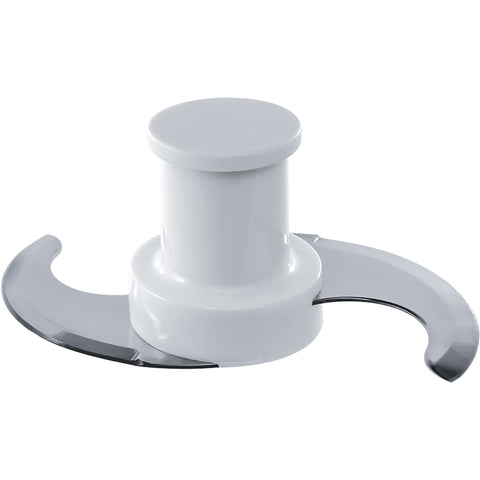
These standard blades are ideal for general chopping, pureeing, and blending tasks. They are perfect for creating smooth sauces, dips, and dressings.
Serrated blades
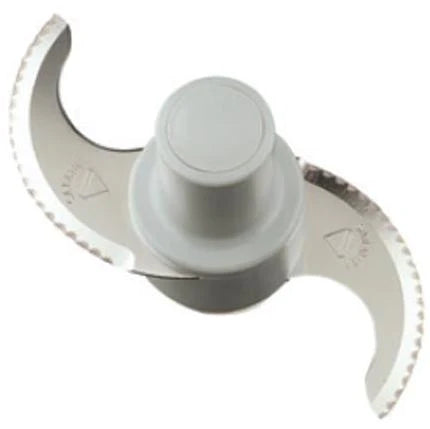
Featuring small, sharp teeth along the edge, serrated blades excel at slicing through tougher ingredients like bread or fibrous vegetables.
They provide clean, precise cuts without crushing the food.
Perforated blades
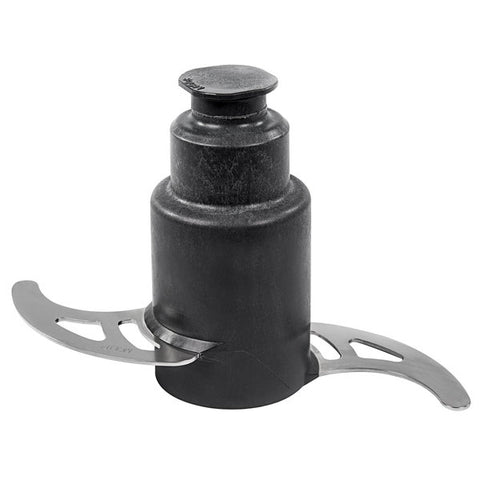
These blades feature evenly spaced holes that allow for precise slicing while preventing sticking or jamming.
They are commonly used for slicing delicate foods like tomatoes or soft fruits.
Slicing discs
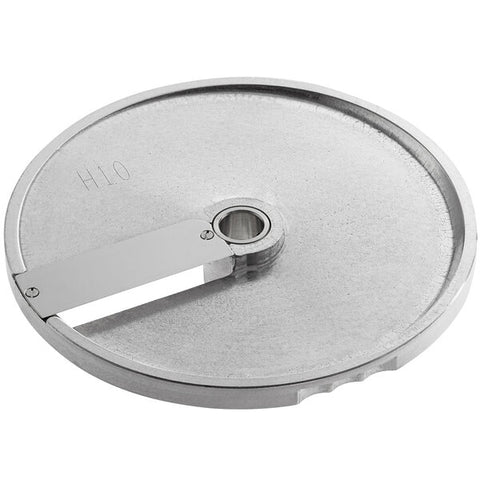
Slicing discs consist of adjustable or interchangeable blades that allow for precise thickness control.
They effortlessly slice through a wide range of ingredients, from vegetables to fruits, delivering consistent results.
Julienne discs
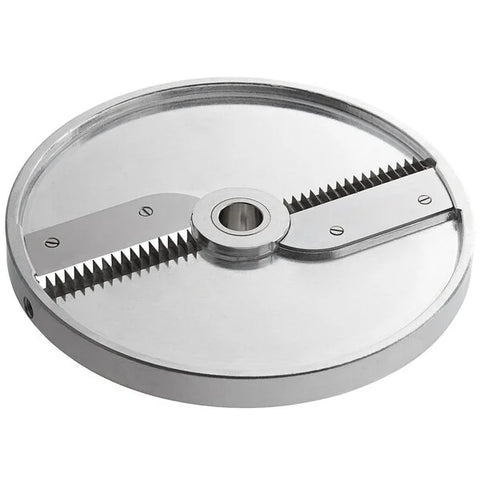
With sharp, evenly spaced blades, julienne discs create thin strips or matchstick cuts.
They are great for preparing uniform vegetable strips for salads, stir-fries, or garnishes.
Grating/shredding discs
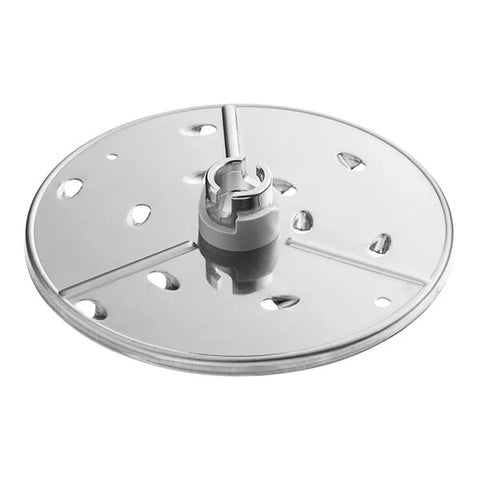
These discs come in various shredding or grating sizes, allowing you to quickly process ingredients like cheese, vegetables, or chocolate.
They offer versatility in creating different textures for various recipes.
Brunoise discs
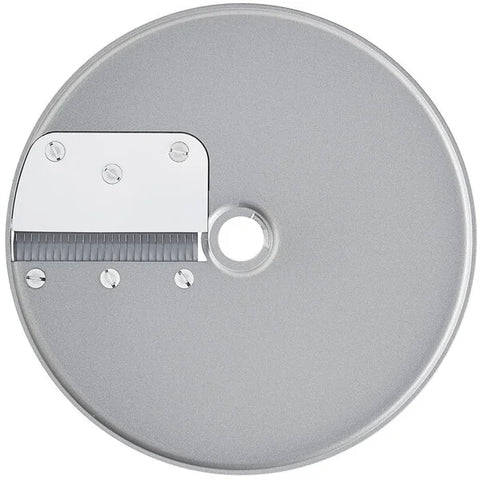
Brunoise discs are designed to create small, uniform cubes or dice.
They are handy for precise and consistent cuts, commonly used for fruits, vegetables, or garnishes.
Whipping discs
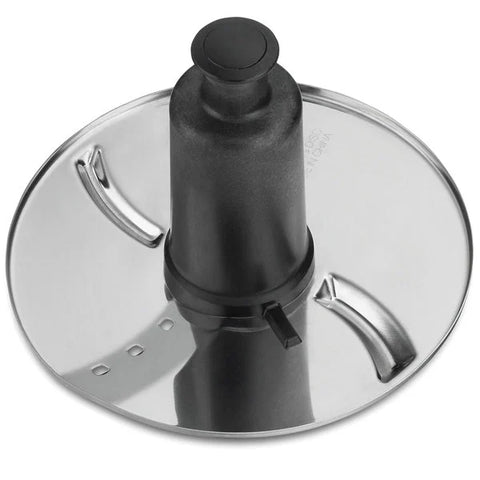
Whipping discs are specialised attachments that transform your food processor into a whipping powerhouse.
They are perfect for whipping cream, beating egg whites, or creating light and fluffy mousses.
Gaufrette/waffle discs
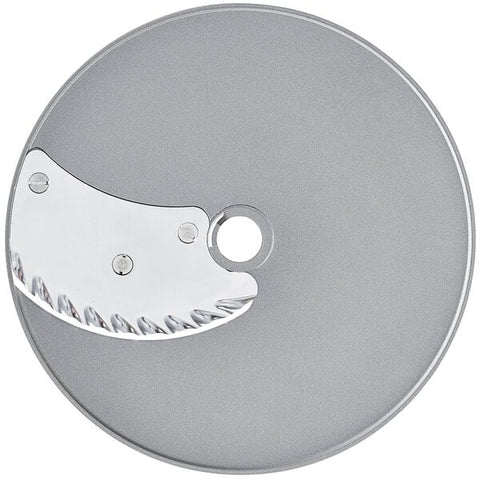
These discs produce waffle-cut slices or crinkle-cut edges, adding visual appeal to your dishes.
They are commonly used for potatoes, carrots, or other firm vegetables.
Dicing kits
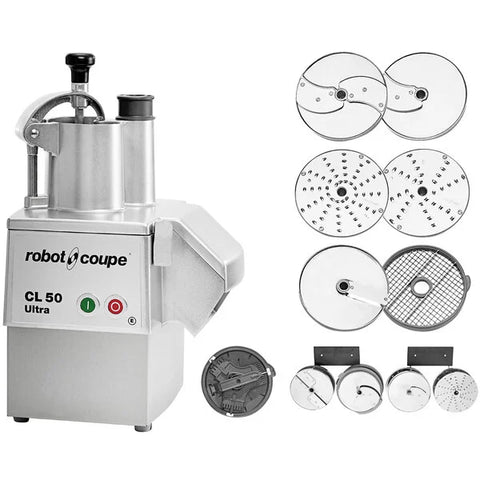
Dicing kits consist of a combination of blades and grids that allow for quick and effortless dicing of ingredients.
They provide consistent cube shapes for salads, stews, or casseroles.
Crimping discs

Crimping discs create decorative crimped edges on dough for pies, pastries, or tart shells.
They add a professional touch to your baked goods.
French fry kits
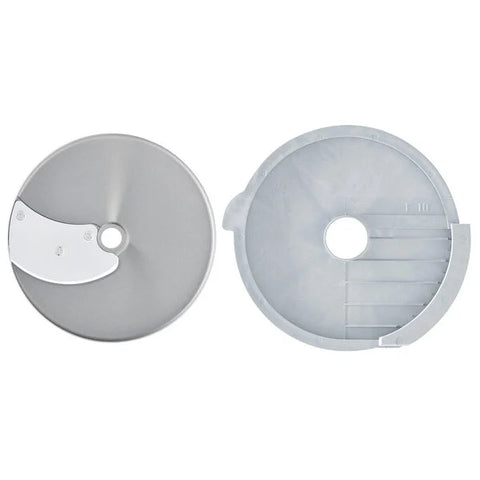
These specialised attachments simplify the process of making in-house French fries.
They quickly cut potatoes into uniform sticks, ready for frying or baking.
Different food processors may come with a varying number of discs and blades, typically ranging from 0 to 16 or more, depending on the model.
Each disc and blade mentioned above offers unique capabilities to process a wide range of ingredients, making your food processor a versatile kitchen companion.
Best commercial food processor Brands
Robot Coupe

Robot Coupe, a pioneer in food processors since the 1960s, is highly regarded in Australian commercial kitchens.
Known for their durability, reliability, and power, these processors can handle heavy usage, making them ideal for busy environments.
Offering a versatile range of models with multiple attachments, Robot Coupe caters to diverse food preparation needs.
The Robot Coupe Food Processor & Veg Prep R211XL is highly recommended for small-scale catering establishments.
With its smooth stainless steel S blade and XL hopper, it offers improved productivity.
The R301 model, on the other hand, features a 3.7-litre polycarbonate cutting bowl and a high-performance vegetable prep attachment, perfect for processing larger quantities efficiently.
Shop Robot Coupe food processors now.
Hallde

Hallde, a Swedish company established in 1941, has been at the forefront of the food processing industry for over eight decades.
With a commitment to design, functionality, and durability, Hallde has earned a global reputation for its high-quality commercial food processors.
In Australia, Hallde is recognised for its robust and reliable food processors that meet the high demands of commercial kitchens.
Their food processors are designed for continuous use, handling high-volume food preparation tasks with ease, thus ensuring efficiency in busy kitchen environments.
The VCB-62 model offers a wide range of functions, including chopping, grinding, mixing, puréeing, blending, and mincing.
With a generous bowl gross volume of 6 litres, it can handle various tasks such as creating aromatic butters, dressings, desserts, purées, pâtés, soups, and more.
Another notable model from Hallde is the VCM-42, which shares the same functions as the VCB-62.
It features two speeds and a pulse function, allowing for greater control and precision.
Shop Hallde commercial food processors now.
Sammic

Sammic, founded in Spain in 1961, has grown into an internationally recognised brand specialising in equipment for food preparation and preservation.
Over the years, Sammic has demonstrated a dedication to innovation and quality, producing appliances that are both efficient and reliable.
In Australian commercial kitchens, Sammic's food processors have proven to be a valuable asset.
These machines are robust, designed to withstand the high-volume, high-intensity environment of commercial food preparation.
They demonstrate a unique blend of power and precision, ensuring that tasks are performed quickly and accurately.
Recommended models include CK-301 and CA-601.
They are ergonomically designed in high-quality stainless steel and have been rigorously tested in the kitchen of renowned Michelin Star chef Martin Berasategui.
With capabilities for grating, shredding, slicing, dicing, and julienning, along with a wide range of discs and grids, these food processors offer versatility and efficiency, capable of producing over 70 different styles of products with an impressive output of up to 1000kg per hour.
Shop Sammic food processors now.
Waring

Waring, a reputable company with a strong heritage, is a leading manufacturer of professional-grade appliances for the foodservice industry.
Known for their commitment to innovation and quality, Waring has earned a trusted reputation in commercial kitchens worldwide.
In Australian commercial kitchens, Waring's food processors are highly regarded for their performance and reliability.
Designed to withstand the demands of high-volume food preparation, these machines are crafted to deliver consistent and efficient results.
Waring's recommended models, such as the WFP14SK and WFP14SCK, offer exceptional performance and durability in commercial food preparation.
The WFP14SK can effortlessly handle large volumes of slicing, shredding, and grating tasks, making it ideal for busy caterers.
The WFP14SCK, with its spacious cutting bowl and powerful motor, is designed to tackle high-volume operations, saving valuable prep time in the kitchen.
Shop Waring commercial food processors now.
Anvil

Established in South Africa in 1966, Anvil has emerged as a prominent and trusted brand within the commercial food service equipment industry.
With a rich history spanning decades, Anvil has earned a solid reputation for its commitment to quality and excellence.
In Australia, Anvil stands as a reliable choice for commercial food processors, offering a range of high-quality equipment that caters to the unique needs of the industry.
Their cutting-edge manufacturing processes, coupled with an in-house engineering team, ensure that Anvil products meet the demanding standards of the Australian market.
The recommended model, FPA0001, features a powerful 1/2 HP motor specifically designed to handle the toughest cheese without compromising motor performance. With a speed of 385 RPM, this food processor can deliver an impressive output of 300kg to 400kg per hour.
Shop anvil food processors now.
Used commercial food processor – worth considering?
Spending thousands of dollars on a new commercial food processor can put a strain on your budget and cash flow.
If you’d prefer not to invest a lot of money in a commercial food processor, a cheaper, pre-owned appliance might be the solution you’re looking for.
SilverChef’s range of ‘Certified Used’ commercial equipment is mostly ex-rental equipment sourced from businesses we know and trust.
The equipment is typically less than two-and-a-half years old, has been fully refurbished by us, and is backed by a three-month parts-and-labour warranty.
Considering the effective, or useful, life of a commercial food processor is around 10 years, you can be sure our Certified Used commercial food processors have plenty of life left in it.
You can either buy or finance the ‘Certified Used’ (and clearance) equipment on our website.
We’re one of the few financiers, if not the only one, in Australia that funds second-hand commercial kitchen equipment.
Read more about ‘Certified Used’ equipment
Commercial food processor frequently asked questions
What is a food processor used for?
While the question may appear to have an obvious answer, it continues to be frequently asked due to the varying levels of familiarity with the full capabilities of commercial food processors.
This powerful kitchen appliance holds untapped potential that even experienced restaurateurs may not fully explore.
Beyond their basic functions, food processors offer versatility that enhances efficiency and unlocks creative culinary possibilities in a commercial kitchen.
Dough kneading
Food processors can efficiently knead dough for bread or pastries, saving time and effort.
Emulsifying ingredients
They can emulsify ingredients to create smooth vinaigrettes, aioli, or mayonnaise, ensuring consistent texture.
Fresh juice extraction
Certain food processors have attachments for extracting fresh juice from citrus fruits, providing preservative-free options.
Texture control
Adjustable speed settings allow chefs to achieve desired textures, from coarse chopping to fine mincing.
Additional attachments
Food processors can be equipped with attachments for tasks like grating cheese or shredding vegetables, facilitating quick and uniform meal prep.
Can food processor be used as a blender?
Yes, a food processor can indeed serve as a blender with the right attachments.
However, it is important to consider the distinction between their intended functions.
While a food processor can handle some blending tasks, its primary strengths lie in chopping, slicing, and grating.
If you require consistent texture and smooth blending, especially in industries like smoothie bars or establishments focused on fine purees, investing in a dedicated blender is advisable.
For industries where versatility and space-saving are key, such as small cafes, utilising a food processor with blender capabilities can be a practical solution.
The decision should be based on the specific requirements and priorities of your establishment to ensure optimal results.
What features should I look for in a commercial food processor?
When shopping for a commercial food processor, it's important to consider key features that align with your kitchen's needs.
These features include:
Speeds
Look for processors with on/off and pulse settings for precise control. Some models offer high and low pulse settings for chopping tasks.
Multifunctional accessories
Ensure the processor comes with a shredding and slicing disk, and check if it offers additional attachments like a juicer or interchangeable blades for versatile food processing.
Dough blade
For those who frequently work with dough, a processor with a dedicated dough blade can improve performance and consistency in kneading tasks.
Touchpad controls
Opt for processors with touchpad controls, which are easy to clean and provide a sleek and modern interface.
Liquid 'max' line
Look for processors with a marked 'Max' line on the mixing bowl to prevent overfilling and potential leaks.
Storage case
Consider models that come with a storage case for convenient organisation of blades and accessories.
Feed tube
A wide feed tube allows for processing larger food items without the need for pre-cutting, saving time and effort.
Equip your kitchen with a commercial food processor that combines these key features, paving the way for culinary excellence and efficiency that will set your establishment apart.
Commercial food processor glossary
Pulse function
A control setting that gives a burst of power for a short duration, allowing more precise control over the processing. Ideal for roughly chopping ingredients or blending delicate items.
S-blade
The most common blade type in a food processor, shaped like an 'S'.
It's used for chopping, mincing, and pureeing ingredients.
Dough blade
A special type of blade designed for kneading dough.
It's typically plastic, unlike other metal blades.
Feed tube
The chute through which food is added into the food processor.
Comes in different styles and sizes based on the model.
Induction motor
A type of motor known for its durability and longevity.
It operates more quietly and has a longer lifespan than universal motors.
Direct drive motor
A motor configuration where the motor is directly beneath the bowl, providing efficient power transfer.
Clutch
A mechanism that disengages the motor when the lid is open or not properly secured, serving as a safety feature.
Keep your cash. Use ours!
Hospitality equipment can be expensive and paying for it outright can put pressure on your business’s cash flow.
Our finance solutions allow you to get the equipment you want now and to pay for it in small, regular amounts out of the revenue it helps generates.
Rent–Try–Buy® not only helps you maintain your cash flow, it also gives you unrivalled flexibility to adapt your equipment to the changing needs of your business.
You can upgrade or buy the equipment at any time or, after 12 months, return or continue renting it.
If you decide to buy the equipment, we’ll give you back 75% of the net rent you paid in the first year and 25% of any rental payments thereafter — to put toward the purchase price.
